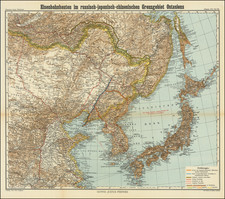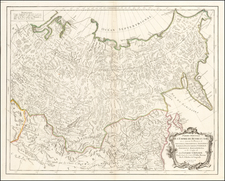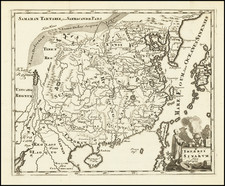Rare French-language plan of the city of Shanghai, with a particular focus on the foreign concessions that existed in the city at the time. The foreign concessions were areas within the city that were governed and administered by foreign powers, rather than by the Chinese government. The map shows three such concessions: one American, one British, and one French, as well as the "Ville Chinoise".
In the mid-19th century, Shanghai was an important international port city and a major center of trade and commerce. The foreign concessions were established in the city as a result of unequal treaties that China was forced to sign with Western powers following military defeats in the Opium Wars. These treaties granted foreign powers the right to establish enclaves within the city where they could set their own laws and administer justice, and they effectively gave these powers extraterritorial rights within Shanghai.
The concessions represented an important aspect of the history of Shanghai, and this map provides valuable insight into the city's layout and the distribution of power within it at the time of its publication in 1861.
Despite being in French, the map was published in London by "J.D. Potter, Agent for the Admiralty Charts, 31 Poultry and 11 King Street, Tower Hill London." This is almost certainly a result of Anglo-French after the Second Opium War. More specifically, the map is probably related to the Battle of Shanghai (1861).
Context: Battle of Shanghai (1861)
The publication of the map was almost certainly spurred by the Battle of Shanghai, which was a major military conflict that took place during the Taiping Rebellion. The Taiping rebels, who were seeking to overthrow the Qing Dynasty, had occupied the city of Shanghai in 1851 and held it for several years before being driven out by Qing forces. In 1861, the rebels attempted to re-capture Shanghai, and a significant battle ensued between the Taiping rebels and the Qing forces that were defending the city. The map may have been intended to provide information about the layout of the city to military forces that were involved in the battle.
Context: The Second Opium War
The Second Opium War, also known as the Arrow War or the Anglo-French expedition to China, was a military conflict fought between the Qing Dynasty of China and the British and French empires from 1856 to 1860. The war was a continuation of the First Opium War, which had ended with the Treaty of Nanking in 1842. The Second Opium War arose from a dispute over the implementation of the treaty, as well as from China's attempts to restrict foreign trade and the spread of Christianity within its borders.
The war began when British and French forces launched a joint military expedition to capture the Chinese city of Canton (now Guangzhou), in response to the Qing government's refusal to open additional ports to foreign trade and to the detention of foreign nationals in China. The expedition was successful, and the Qing government was forced to sign the Treaty of Tianjin in 1858, which granted Western powers even greater concessions and privileges in China, including the right to station diplomatic representatives in Beijing.
The war continued for several more years, as British and French forces expanded their military operations to other parts of China. In 1860, the Qing government was forced to sign the Convention of Peking, which formally ended the war and granted Western powers even greater concessions, including the right to station troops in Beijing and to have their own legal jurisdictions in certain parts of the country. The treaties signed during the Second Opium War were a major turning point in China's history, as they paved the way for the country's "century of humiliation" at the hands of foreign powers.
Rarity
No examples traced in OCLC. We find one text online referring to the map, titled "Shanghai Systematische Bibliographie. 3. erweiterte Aufl." however, there is no additional information about the map other than a list entry.










![[Map of Western Shangdong Province]](https://storage.googleapis.com/raremaps/img/small/60891.jpg)

![[Shannxi Province] Xensi, Imperii Sinarum Provincia Tertia](https://storage.googleapis.com/raremaps/img/small/99964.jpg)
![[Comprehensive Map of China] 支那全圖 Shina zenzu](https://storage.googleapis.com/raremaps/img/small/65521.jpg)
